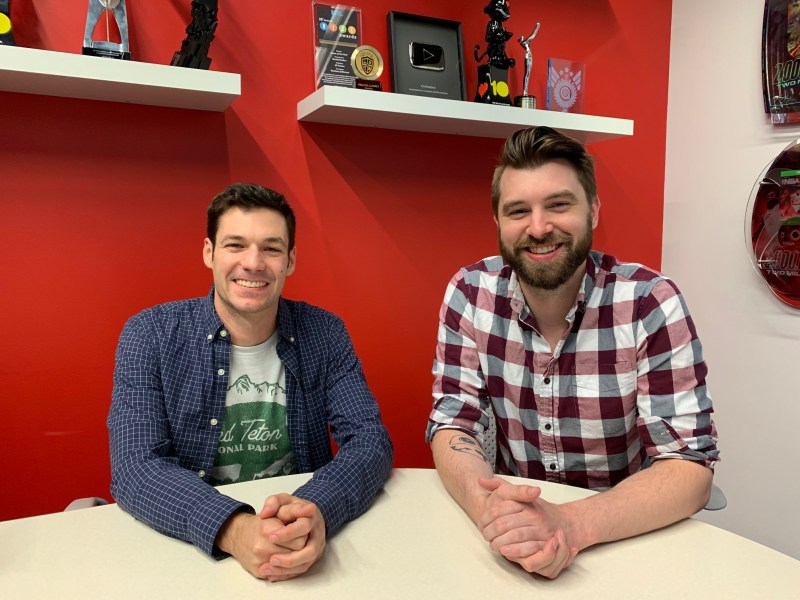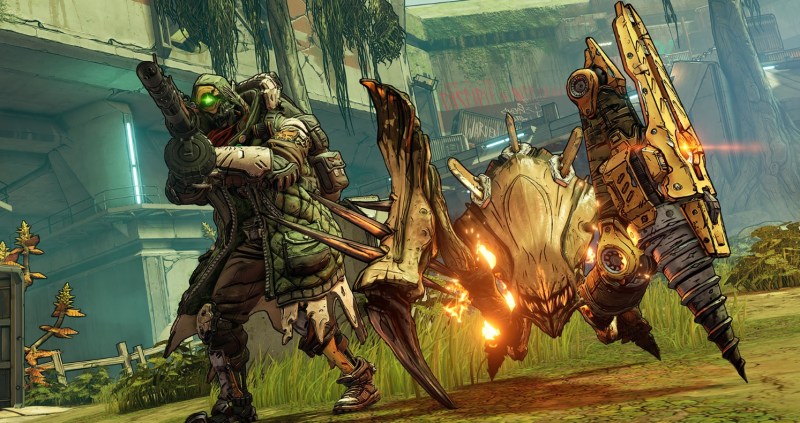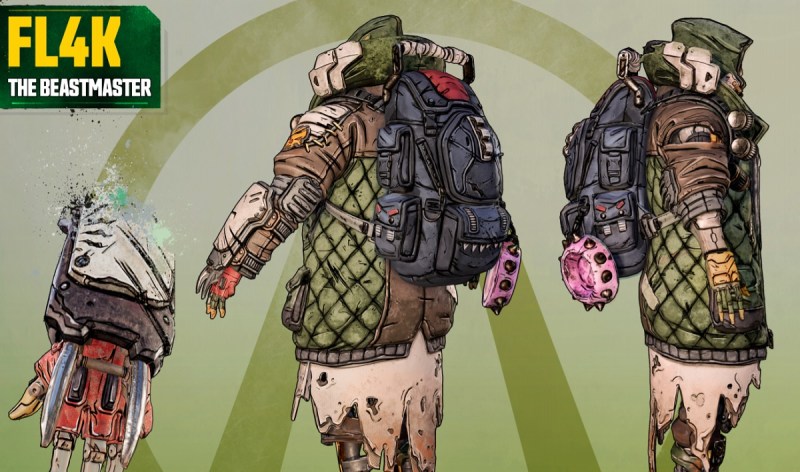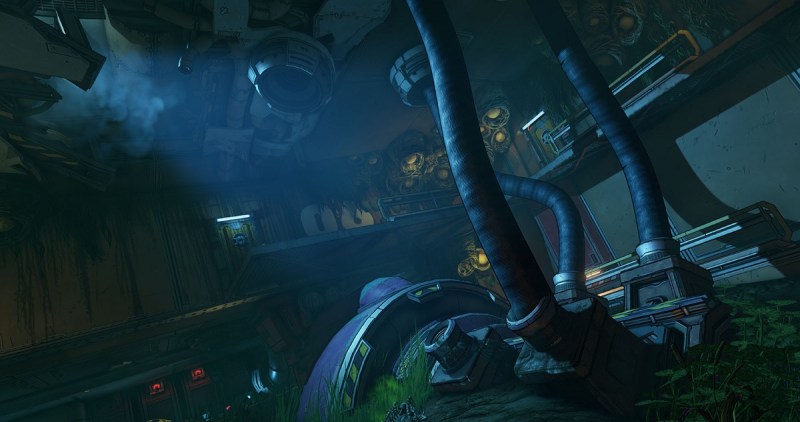Borderlands 3 has some big shoes to fill as it tries once again to be the violent first-person shooter that makes you laugh out loud. From the beginning moments where you reassemble the sassy Clap Trap robot companion to the cuddly teddy bear Balex, voiced by Ice-T, Borderlands 3 will make you chuckle.
I know this because I played a few hours of Gearbox Software’s Borderlands 3 at game publisher 2K’s offices in Novato. Then I spoke with the writers Danny Homan and Sam Winkler, who had to bring the world beyond Pandora and the dialogue of the twin villains, Tyreen and Troy Calpyso, to life.
Gearbox Software has a lot to live up to with this title, which debuts on September 13 on the PlayStation 4, Xbox One, and Windows PC. The series has sold more than 48 million copies since the first title debuted in 2009. But it’s been a long time since Borderlands 2 debuted in 2012 and Borderlands: The Pre-Sequel came out in 2014. Gamers are chomping at the bit to see Pandora again, as well as the new planets in the game such as Eden-6.
Homan and Winker had to think up new villains to replace the memorable Handsome Jack. They came up with the Calpyso twins, a brother-and-sister duo who livestream (or Livescream) their slaughter to followers known as the Children of the Vault. I only played a short few hours of the game, which could last 30 to 35 hours. But I thought it had some very funny parts.
June 5th: The AI Audit in NYC
Join us next week in NYC to engage with top executive leaders, delving into strategies for auditing AI models to ensure fairness, optimal performance, and ethical compliance across diverse organizations. Secure your attendance for this exclusive invite-only event.
Here’s an edited transcript of our interview.

Above: Borderlands writers: Danny Homan (left), senior writer; and co-writer Sam Winkler.
GamesBeat: Have you been on the project from the beginning?
Danny Homan: I feel like it existed as a text document before we came on, but we’ve been on there for about three years.
GamesBeat: I talked with Paul Sage, the creative director of Borderlands 3 during E3, and I remember him saying he came in from the outside and got the whole thing going. Did you come in after him, as the team was coming together?
Sam Winkler: Yeah. At the time the lead writer was Mikey Neumann, who was the writer of Borderlands one. We came on to supplement his work. Unfortunately he had to leave due to health reasons, and so we took over the mantle. It’s been really interesting co-developing that. Two very distinct voices. We’re still figuring out what our Borderlands voice is, and we came to some very interesting conclusions in Borderlands 3.
Homan: Mostly we try to make each other laugh, make the entire studio laugh. If we can do that, we’re doing something right.

Above: Fl4k is a Beastmaster among the Vault Hunters.
GamesBeat: Paul said that one of the mandates was that you had to have multiple planets.
Winkler: Yeah, yeah. Explore the universe. We’ve seen Pandora quite a bit in the previous games. We still get our fair share of it in Borderlands 3, but the whole galaxy opened up once we said, “OK, we’re getting on a new ship and seeing new spaces.”
Homan: A fun challenge has been, how do you export that dark humor that we love in the Borderlands franchise from Pandora to Eden-6 and other planets?
GamesBeat: The twins were a big development as well, conceiving them as the enemy.
Homan: Absolutely. Having a brother and sister duo is a cool opportunity. If you have a sibling, you know so much about them. That’s such a wonderful and dangerous opportunity for villains. When they’re together, they’re a force to be reckoned with, but occasionally, like brothers and sisters, they fight. They have a conflict. That’s interesting and entertaining as well.
Winkler: We were constantly asking ourselves how we’d follow up on Handsome Jack. He’s one of the most recognizable video game villains of all time. The reality was, just don’t try to do Jack again. We wanted to make sure the voices of the villains were unique and felt relevant in 2019. We took this previous idea, where in Borderlands the villains are these corporate faces. They’re a hit squad, or they’re this megalomaniac charismatic tyrant. We went away from the corporations a bit and said, “What about this crowdsourced, homegrown cult of personality?”
That unlocked a lot of ideas for us. They’ve managed to do what no one could do before and take this disparate bandit clans and bring them all together. So then we asked, “How do you get that popular?” Well, these days you become a streamer.
Homan: Big streamers have that rare charisma, something about them. You have to be entertaining enough to accrue a mass following. Then the question becomes, how do you keep that following and grow that following? You have to keep on escalating and doing different things. That’s a cool formula for villains.

Above: Borderlands 3’s Eden-6 planet is a swamp with dinosaurs.
GamesBeat: How present are they throughout the game? Are they always there?
Winkler: You’ll hear from them and see their effects pretty vividly. One of the things about the Borderlands universe is that it has the echo system, which for better or for worse — people can ping you any time they like. They just call you up and say, “What’s up, idiot” while you’re trying to get something done. Some of the most fun is just in having the villains roast the player sometimes.
GamesBeat: It sounds like there’s an enormous amount of writing in that. How do you keep them fresh?
Homan: Part of it is that dynamic between the two of them. When you meet the Calypsos at the beginning of the game, Tyreen is the entertainer. She’s the show-person, the really charismatic one. Troy is kind of on the sidelines, managing the cult, stoking the flames of their atrocities. But as the story progresses some interesting things happen that shift and change that power dynamic.
GamesBeat: So they’re not just there to annoy you.
Winkler: Yeah, they have their reasons. They’re not just dicks for dicks’ sake. But in terms of keeping that fresh, one of the cool things about Borderlands is that the enemies are very vocal. The player characters are very vocal. Instead of having to rely on enemies calling you up and saying, “I’m evil for this reason, let me tell you why,” we actually do a lot of world-building in the enemy callouts, showing that they’re religiously devoted to these twins and stuff like that. We find out a lot more about it just from incidental combat stuff.
There are so many different voices. At any time one of us feels like, “I think I’ve written my share of this one character,” we can throw to the other and get their spin on it. That’s been really cool.
Homan: Another aspect of our process that’s enjoyable is that our actors really do help us inform the characters and help them grow. Not only actors from past games in the franchise, but also our new actors. We’ll write some stuff and we’ll be engaged by it, and then we’ll get into the booth and riff and allow them to take the character on. Sometimes the best lines in Borderlands aren’t written by us. They’re the actors just becoming that character.
Winkler: Zehra Fazal, the voice of Amara, we really knew we’d done a good job casting when she started throwing some Urdu into her lines. Just stuff we hadn’t written. We said, “Yes, more of that, please!” That felt really good.
Homan: Same thing with Cian Barry, who plays Zane. He taught us a lot about some interesting Irish slang.

Above: Fl4k doesn’t look so tough from this view.
GamesBeat: As far as how you put it all together, do you have something like a writers’ room? Do you have a whole group in one place?
Homan: We often start by taking a main mission or a side mission, a battle grid. We’ll look at it together and think about what’s working and what we can punch up or make different. Sometimes someone will take another stab at a script to give a fresh perspective.
Winkler: When we’re developing stuff toward the beginning, getting that high-level map of what the storyline looks like before we write actual scripts, we have a narrative group. We meet multiple times a week and compare notes on what we think needs to be done. We make big decisions. Then we retreat and say, “OK, we have our marching orders to fill in these areas.” Our managing producer, Randy Varnell, who’s in charge of the narrative team, has been good at keeping us corralled on that one.
Homan: One thing we’ve been doing that’s more unique to this project is we do live readings. We’ll have a script and we’ll call in a bunch of devs to read parts. That’s where you start to hear what the character dynamics are, what’s working and what isn’t. We go back and revise based on that.
GamesBeat: In co-op, it feels like somebody might be near you, or they might not be. I wonder how you handle dialogue when that happens, when you’re not sure where the other character is.
Winkler: That’s a kind of shorthand we have. Someone will suggest something in a room and someone else will say, “Co-op.” [laughs] It’s inevitable, if you have two people with free will, they’re going to stomp over some stuff pretty good. One handy thing is, we have a prioritization system, to make sure people hear the most pressing information about a mission. If player two is off to one side doing collectibles, stuff like that, that won’t overwrite the important main mission they’re doing.
But another factor we’ve changed since Borderlands 2 is that now, when you’re picking up echo logs, recorded audio, that now goes into your menu. You can always replay those at any time. You don’t just have the one chance to hear it. For people who are interested in those little bits of side lore, they can go find it and not have it be a goose chase.

Above: Eden-6 has very different vibes in Borderlands 3.
GamesBeat: You have Claptrap and — is that the navigator guy?
Homan: Balex, yeah.
GamesBeat: They’re there to anchor a lot of this messaging or communication to the player?
Winkler: A lot of games writing is figuring out how to say the same thing five times without making it feel stale, whether that’s an enemy who has to shout “GRENADE!” or reiterating what the mission objectives are without it sounding like, “For the last time, please go do this.” The players want to do the mission objectives. They just need to know what it is and be entertained along the way.
GamesBeat: Do they serve as that kind of advice, then? They’re always there for the writer, because they’re always in a certain place.
Winkler: That role is fulfilled by various different characters throughout the game. If we attached the player to one particular character, they might get tired of them halfway through. We have a really varied cast of characters that have different reasons for helping out.
Homan: There are definitely some missions where you’ll do something with an NPC, going on an adventure, but you can always come back to Sanctuary, your ship, and talk to the characters you’ve met along the way. Not only will we have side missions, but we’ll also have contextual dialogue. They can talk about past things that have happened in the game. You can interact with them.
